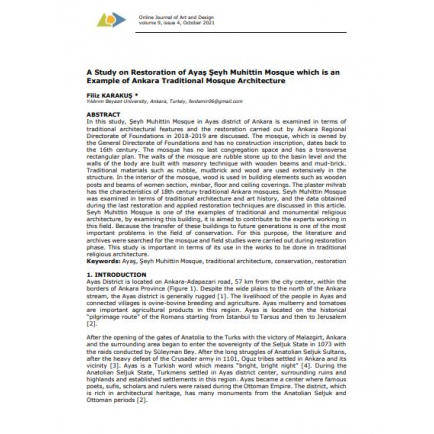
The iconography of Iranian-Islamic Mosques (Case studies: Sheikh Lotfollah and Kaboud Mosques)
Date Added
26/06/2022
Content Type
Article
Category
Magazine
Link to Content
Subject Area
Mosques
Author
Filiz Karakuş
Publisher Name
Online Journal of Art and Design
Year of Publication
2020
Description
In this study, Şeyh Muhittin Mosque in Ayas district of Ankara is examined in terms of traditional architectural features and the restoration carried out by Ankara Regional Directorate of Foundations in 2018-2019 are discussed. The mosque, which is owned by the General Directorate of Foundations and has no construction inscription, dates back to the 16th century. The mosque has no last congregation space and has a transverse rectangular plan. The walls of the mosque are rubble stone up to the basin level and the walls of the body are built with masonry technique with wooden beams and mud-brick. Traditional materials such as rubble, mudbrick and wood are used extensively in the structure. In the interior of the mosque, wood is used in building elements such as wooden posts and beams of women section, minbar, floor and ceiling coverings. The plaster mihrab has the characteristics of 18th century traditional Ankara mosques. Seyh Muhittin Mosque was examined in terms of traditional architecture and art history, and the data obtained during the last restoration and applied restoration techniques are discussed in this article. Seyh Muhittin Mosque is one of the examples of traditional and monumental religious architecture, by examining this building, it is aimed to contribute to the experts working in this field. Because the transfer of these buildings to future generations is one of the most important problems in the field of conservation. For this purpose, the literature and archives were searched for the mosque and field studies were carried out during restoration phase. This study is important in terms of its use in the works to be done in traditional religious architecture.
Files
AStudyonRestorationofAyasSeyhMuhittinMosquewhichisanexampleofAnkaraTraditionalMosqueArchitecture.pdf





